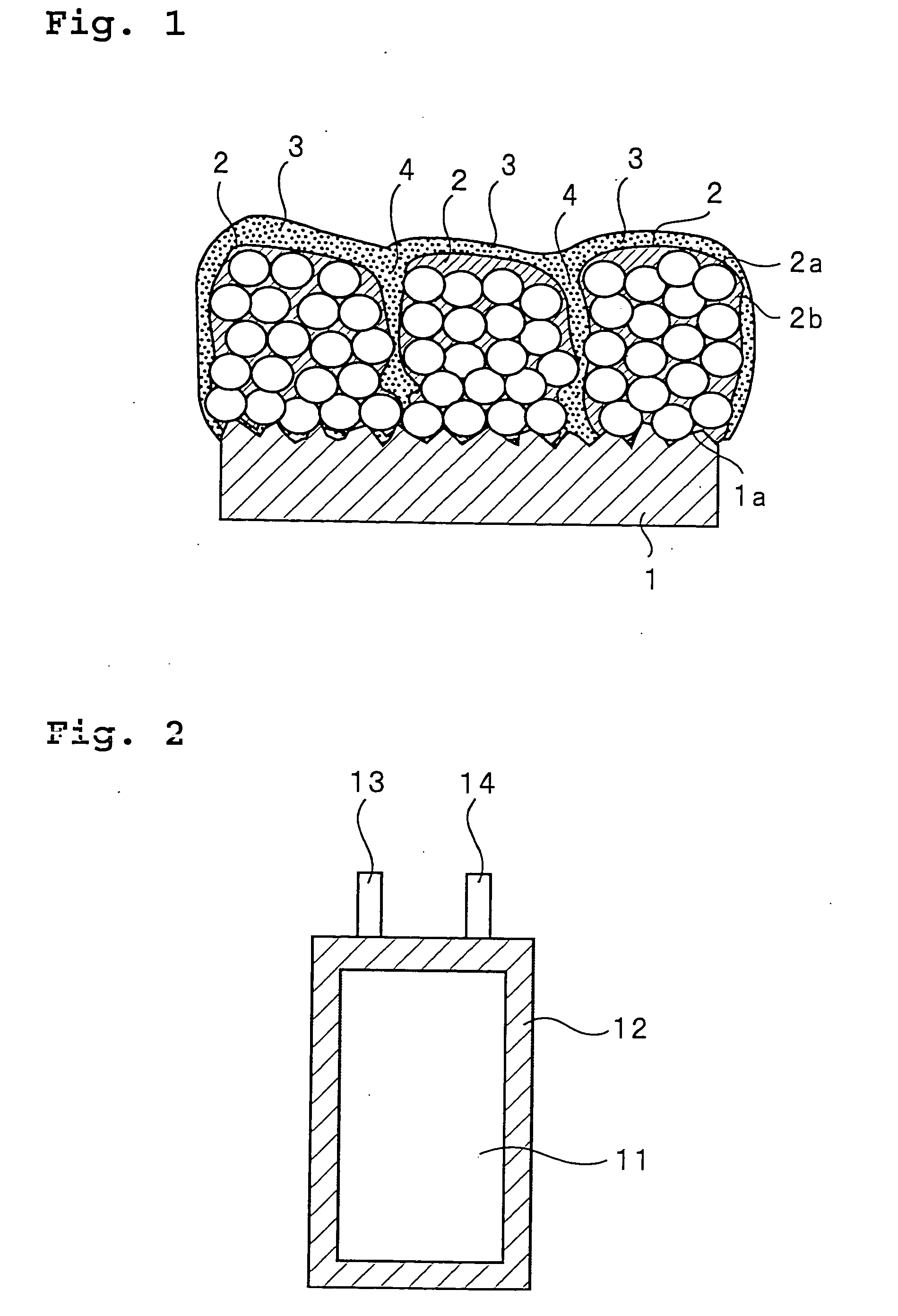Lithium secondary battery and method for manufacturing thereof
- Summary
- Abstract
- Description
- Claims
- Application Information
AI Technical Summary
Benefits of technology
Problems solved by technology
Method used
Image
Examples
experiment 1
Preparation of Negative Electrode
[0067] 81.8 parts by weight of the silicon powder (purity 99.9%) was added to 8.6 weight % of a N-methyl-2-pyrrolidone solution containing 18.2 weight parts of polyimide as a binder and the components were mixed and kneaded by a pestle in a mortar to prepare a negative electrode mixture slurry.
[0068] The slurry was coated on one surface of an electrolytic copper foil (thickness: 35 .mu.m) having a surface roughness (Ra) of 0.5 .mu.m which is a current collector, and was rolled after drying. The coated copper foil was sintered by heating at 400.degree. C. for 30 hours under an argon atmosphere to prepare a negative electrode. The thickness of the electrode (including the current collector) was 50 .mu.m. Therefore, the thickness of the active material layer was 15 .mu.m. Thickness of the active material layer (X) / surface roughness of the copper foil (Ra) was 30. Thickness of the active material layer (X) / thickness of the copper foil (Y) was 0.43.
[0069]...
experiment 2
[0077] Battery B1 was prepared in the same manner as in Experiment 1 except that the temporary-battery was not charged and discharged.
[0078] Battery B2 was prepared in the same manner as in Experiment 1 except that an electrolyte without a monomer and a polymerization initiator was used instead of the pregel solution.
[0079] Charge and discharge cycle characteristics of batteries A1, B1 and B2 were evaluated. Each battery was charged to 4.2 V at a current of 100 mA and 25.degree. C., and then was discharged to 2.75 V at a current of 100 mA and 25.degree. C. (this is considered to be one charge and discharge cycle). The number of cycles to reach 80% of the discharge capacity of the first cycle was measured to determine the cycle life of the battery. The results are shown in Table 1. The cycle life of each battery is shown as an index when the cycle life of the battery A1 is taken as 100.
1 TABLE 1 Charge / Discharge of Pregel Battery Temporary-battery Solution Cycle Life A1 Yes Yes 100 B...
experiment 3
[0083] The effect of surface roughness (Ra) of the current collector was evaluated.
[0084] Batteries A2 and A3 were prepared in the same manner as Experiment 1 except that electrolytic copper foils having a surface roughness (Ra) of 0.2 .mu.m and 0.17 .mu.m, respectively, were used instead of the electrolytic copper foil having a surface roughness (Ra) of 0.5 .mu.m.
[0085] Cycle characteristics of batteries A2 and A3 were evaluated in the same manner described above. Cycle life is described as an index when the cycle life of battery A1 is taken as 100. Table 2 also includes the cycle life of battery A1.
2 TABLE 2 Roughness of Surface of Current Collector Battery (.mu.m) Cycle Life A1 0.5 100 A2 0.2 87 A3 0.17 76
[0086] As is clear from the results shown in Table 2, batteries A1 and A2 prepared using a current collector having a surface roughness (Ra) of at least 0.2 .mu.m have excellent cycle characteristics as compared to battery A3 prepared using a current collector having a surface r...
PUM
| Property | Measurement | Unit |
|---|---|---|
| Fraction | aaaaa | aaaaa |
| Fraction | aaaaa | aaaaa |
| Time | aaaaa | aaaaa |
Abstract
Description
Claims
Application Information
 Login to View More
Login to View More - R&D
- Intellectual Property
- Life Sciences
- Materials
- Tech Scout
- Unparalleled Data Quality
- Higher Quality Content
- 60% Fewer Hallucinations
Browse by: Latest US Patents, China's latest patents, Technical Efficacy Thesaurus, Application Domain, Technology Topic, Popular Technical Reports.
© 2025 PatSnap. All rights reserved.Legal|Privacy policy|Modern Slavery Act Transparency Statement|Sitemap|About US| Contact US: help@patsnap.com



